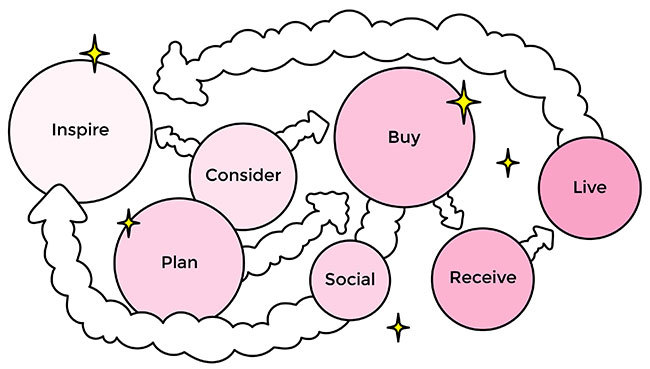This article presents content originally published in DesignMind, a design journal operated by frog, under the supervision of Noriaki Okada of Dentsu Inc.'s Experience Design Department.
 To survive in today's fiercely competitive retail industry, companies must differentiate themselves by focusing their efforts on a single point within the customer journey (the process a customer goes through before purchasing a product) and offering a unique, new experience. The key is not to conquer the entire journey, but to identify the "magic moment" when the customer decides to buy.
To survive in today's fiercely competitive retail industry, companies must differentiate themselves by focusing their efforts on a single point within the customer journey (the process a customer goes through before purchasing a product) and offering a unique, new experience. The key is not to conquer the entire journey, but to identify the "magic moment" when the customer decides to buy.
The era of uniform customer journeys is over
Traditional retail customer journeys were largely linear and unidirectional. They began with motivating and stimulating purchase intent, ending when the customer used the purchased product.
 However, with the advent of online shopping, mobile shopping, and social media, the customer journey is no longer one-directional. Consumers not only move back and forth, but also stop and start at will, sometimes even skipping entire steps of the process.
However, with the advent of online shopping, mobile shopping, and social media, the customer journey is no longer one-directional. Consumers not only move back and forth, but also stop and start at will, sometimes even skipping entire steps of the process.
For example, while shopping on Amazon, you might reach the checkout page (just before purchase) and see "recommended items" related to what's in your cart, starting a new journey.
Or, when checking in for a United Airlines flight, pressing the "Book Uber" button built into the check-in app could eliminate the need to consider transportation to the airport (taxi, rideshare, personal car, etc.).
Or, after reading a negative review from a complete stranger on TripAdvisor, you might change your plans or cancel a hotel reservation.

Finding the Magic Moment
Companies are striving to differentiate themselves by focusing their efforts on specific processes within the customer journey, taking into account industry trends and changing customer needs.
Amazon, for example, was a pioneer in optimizing the "purchase" process, designing it to ultimately favor the company. Its patented "1-Click Ordering" allowed consumers to buy without going through a shopping cart. This convenience, speed, and efficiency perfectly suited customers who wanted to get their shopping done as quickly as possible.
While groundbreaking in 1999, today's customers—nearly two decades later—aren't solely those who want to buy quickly. Following Amazon's lead, retailers and consumer goods manufacturers are enhancing their competitiveness by focusing on specific processes within the customer journey, implementing unique innovations to make their products and services more memorable.
So, let's consider what specific innovations retailers can implement for each process within the customer journey.
1. Motivation (INSPIRE)
This is the stage where many companies focus their efforts. To differentiate themselves during "Inspire," they leverage social media and influencers, who wield significant influence over buyers. Houzz, a platform for home design, effectively connects this inspiration to business by using crowdsourced, appealing interior photos to match users with companies offering furniture, fixtures, and related services, and by facilitating information sharing among users. Retailers like Uncrate and Bonobos, which offer products aligned with specific lifestyles, also emphasize the "Inspire" stage of the journey. They connect their offerings to customers' lifestyles, disseminate information about products and services through social media like Instagram, and drive sales.
2. Consider
Marketers have long strived to position their brands within consumers' consideration sets when they need or desire something. Consequently, they pour ideas and funds into advertising to ensure their products or brands are top-of-mind.
The problem is that while many brands compete for attention, most consumers don't engage in deep consideration. Especially in "low-commitment" categories, consumers have no strong preference for which product or brand to use and are willing to switch based on convenience. Amazon Dash Button and Amazon Subscribe & Save are strategies that capitalize on this low level of consideration. Since consumers can reorder without thinking, they see little reason to switch to another brand.
Conversely, companies like Progressive, a suspension manufacturer for the automotive aftermarket, leverage price comparison tools. By making it immediately clear they offer the lowest price, they ensure consumers choose them. The increase in options meeting consumer needs, combined with easily accessible information from search engines like Google and Baidu, erodes brand loyalty and introduces competition into the "consideration" process.
3. Planning and Research (PLAN & RESEARCH)
This process has also been a focus relatively early on in online and mobile shopping. For example, travel sites like Expedia and Hipmunk have built their businesses around the "research" stage of the customer journey.
Comparison shopping sites for other categories, like fashion and automobiles, also emerged. These sites focus on the "planning" stage of the journey, positioning themselves as knowledgeable guides within the now-endlessly varied online retail landscape. For many people, buying something without first checking a comparison site is now unimaginable.
The rest of this article is available on the web magazine "AXIS".
Timothy Morley
Business & Product Strategist at frog and leader of the global team. His team collaborates with designers and engineers to bring innovative solutions to market. He spent 15 years in Silicon Valley, working on diverse products, strategies, and marketing.


 To survive in today's fiercely competitive retail industry, companies must differentiate themselves by focusing their efforts on a single point within the customer journey (the process a customer goes through before purchasing a product) and offering a unique, new experience. The key is not to conquer the entire journey, but to identify the "magic moment" when the customer decides to buy.
To survive in today's fiercely competitive retail industry, companies must differentiate themselves by focusing their efforts on a single point within the customer journey (the process a customer goes through before purchasing a product) and offering a unique, new experience. The key is not to conquer the entire journey, but to identify the "magic moment" when the customer decides to buy. However, with the advent of online shopping, mobile shopping, and social media, the customer journey is no longer one-directional. Consumers not only move back and forth, but also stop and start at will, sometimes even skipping entire steps of the process.
However, with the advent of online shopping, mobile shopping, and social media, the customer journey is no longer one-directional. Consumers not only move back and forth, but also stop and start at will, sometimes even skipping entire steps of the process.


